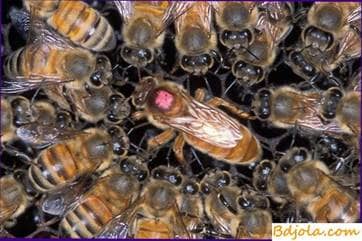
To the newly planted uterus in the cells, bees do not always treat the same: sometimes they are accepted willingly, but there are cases that they do not accept or kill at the release. It depends on external conditions (season time, bribe), family status and the quality of the grafted queens. Having lost the uterus, the bees are worried, restlessly running around the hives, honeycombs, etc., and only by laying queen cells, gradually calms down.
Bees constantly surround the uterus, offer her from her proboscis the most nutritious food – milk, than induce the uterus to lay egg. If the famine threatens the family, then for the survival of their lives, worker bees mercilessly suck molochko first from the uterine cells and their larvae, then from the drone, and expel the adult drones. In the extreme case, even the bee larvae are sucked out and empty shells are thrown out of the hive. With incessant hunger, bees are divided by food remnants, weaken and die one after another, but the uterus is left with the last drop of food. As a result, the uterus dies among the latter.
Similarly, bees are strongly attached to brood. Their concern for brood is amazing. Moving from cell to cell, they continually look into them and feed the larvae of food enough and if the temperature in the nest is lowered, the bees, while bored, heat those honeycombs where there is brood.
If there is a brood in the nest, the bees do not usually leave it. Therefore, to ensure that swarms do not fly off after landing them in the hive, they are usually given one frame with brood.
Можно давать муку пчелам. Пчела вид животных.
The bee family and its composition